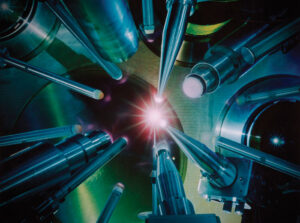Smooth implosions
Researchers the world over want to realise hydrogen fusion as a safe, sustainable and low-carbon energy source. The mainstream approach is to use magnetic cages – tokamaks and stellarators – to confine the hot fusion fuel, which is a 50-50 mixture of the heavy hydrogen isotopes deuterium and tritium. But other approaches do exist: inertial fusion for instance, where millimeter-sized fuel pellets are compressed in a laser bombardment until they go off like miniature nuclear explosions.
The conventional approach in inertial fusion – if there is anything conventional about laser shots that compress a teardrop of fuel until it’s 1000 times more dense than at room conditions – is to reach extremely high pressures while maintaining the same high temperatures as in a tokamak. Those pressures keep the pellets together long enough for the atoms in the fuel to undergo fusion reactions and produce an excess of energy, explains inertial fusion researcher Vladimir Tikhonchuk at the University of Bordeaux.

Unstable

The Achilles heel of inertial fusion is uneven compression of the fuel pellets. Ideally, the pinhead-sized amount of fusion material is squeezed smoothly and evenly until it reaches fusion conditions, but in practice it’s like squeezing a ball of jelly between your fingers – it will find the tiniest weak spot and blob out. So far, uneven compression of the fuel pellets has foiled inertial fusion, although experiments in the US National Ignition Facility have succeeded in producing of more than 50 kJ of fusion energy, or about three percent of the total laser energy that goes into compressing the pellets.
Right here is where the Hungarian-Norwegian researcher László Csernai comes in. Back in 2015 and 2018, he described an out-of-the box way to detonate the entire fuel pellet at once in the scientific journal Laser and Particle Beams. Nanoscale gold dust mixed in with the fuel, think Csernai and his colleagues, can efficiently absorb the incoming laser light and make sure the entire fuel pellet goes off at exactly the same time. But rather than triggering ignition, Csernai started a slow-burn scientific discussion that continues until today.
Airy
“The approach proposed by Csernai and his colleagues is motivated by their desire to avoid the very unstable process of fuel implosion”, thinks Tikhonchuk’s colleague Dimitri Batani. Instead, the researchers want to reach fusion conditions by using only weakly- or uncompressed fuel pellets at higher temperatures, by turning part of the laser energy into heat. Batani and Tikhonchuk are critical about this approach: for the laser to be able to propagate through the pellet and heat it, the pellet must have a density under ten times that in uncompressed condition, which is far too sparse for producing energy from fusion reactions.
Csernai does not appear discouraged: in a recent paper on the scientific pre-publication website arXiv, he writes that the detonation wave lit by his laser pulse and gold nanodust would travel at the speed of light – so fast, in other words, that nothing could go faster; the fuel pellet would literally have no time to expand before igniting.
Speed of light or not, the fuel density and the rate of fusion reactions are really the crucial points, says Batani: “With the weak fuel compression that Csernai proposes, the atoms are too far apart to meet and fuse together in great numbers.” Worse, while the laser pulse may get absorbed by electrons throughout the entire pellet at the speed of light, it still takes much more time to transfer that energy to the deuterium and tritium ions. Tikhonchuk: “Take that time into account, and the extra heat will simply blow the pellet apart or radiate away before the fusion process can produce any noticeable amount of energy.”
So far, nanoplasmonic fusion has stayed confined to scientific publications in specialist journals. And while Batani and Tikhonchuk welcome new ideas to advance fusion, that’s where they think this particular idea should stay: “Any new ideas need to be based on solid physics, or else you’re just creating false expectations”, states Batani. Tikhonchuk agrees: “To realise fusion energy, we need to do it the old-fashioned way, through hard and sound research including theoretical ideas, experiments and technology development.”
Read more on NIF
